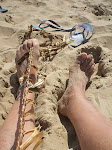Some months ago, National Life Stories at the British Library asked me if I would be willing to record my “Life Story” for posterity. For some time now, my name has appeared in English school exam papers and so I get emails from students asking me to tell them my life story. It struck me that a recording could be a good resource, and would save me having to explain why their request is tricky for people who have lived a few more years than they have. So I agreed and last week I spent almost 12 hours answering well-researched questions about both my personal and work life.
National Life Stories is a charitable trust based in the British Library whose brief is to 'record first-hand experiences of as wide a cross-section of present-day society as possible'. The recordings are housed in collections such as ‘Architects' Lives’, ‘Artists Lives’, ‘Lives in the Steel Industry’, ‘Medical Lives’ etc. The one that my recording will be in is 'Craft Lives' and at some future date, it will be available to listen to, either at the British Library or as a download. I will post the details here for those of you desperate to hear it (my parents) when I get the information!
It was a strangely exhausting experience as even the most garrulous amongst us (and I do not count myself among their number) don’t normally talk for two hours at a time. I imagine it resembled a session with a psychotherapist more than anything and for the first time in my life, the bizarre nature of my parents’ home life started to register with me. My fathers’ work required that they move house almost every six months during my teens, yet this was something that at the time I accepted as normal, if a bit annoying. My interviewer, Frances, deserves a medal for staying awake and asking intelligent questions every day even though the temperature refused to fall below a sultry 24C. She pointed out that I am always seeking to make lightweight work that packs easily and suggested that it may be a consequence of this nomadic childhood. It is an interesting point that I had not considered before, I always thought it was because I needed to reduce the cost of postage!
There is no editing so everything I said is there in perpetuity. But, the interviewee is given the right to mute out the things that they wish they had not said, for a maximum of 30 years. On the whole I was nice about everybody. The exceptions are my first basketry teacher, and my excruciatingly boring history teachers. I still have not forgiven the latter for making the very raunchy story of Henry VIII so tedious. Thanks to the recent TV series 'The Tudors' I now know just how raunchy this story was. I also had little praise for a Welsh ‘English’ teacher in Tenby who destroyed the magic of Shakespeare’s prose and poetry for me. He also used me as a scapegoat for all his vengeance against England
 |
| The studio: one of the things I was asked to describe |
Whilst I am on the theme of the British Library my Doctoral Thesis "Grown Home an exploration of processes for the manufacture and cultivation of willow products,Royal College of Art, 2003" has now been digitised and is available to download on line.
Surprisingly, it was done because quite a few people have wanted to read it. I hope they got something of use out of it. Strangely, I haven’t received any copyright fees for it and yet I am sure I signed a piece of paper in 2003 that said I would receive something when anyone read it! I must hunt that bit of paper out, yet another case of “if you don’t ask you don’t get” …..last week I was certainly asked!







